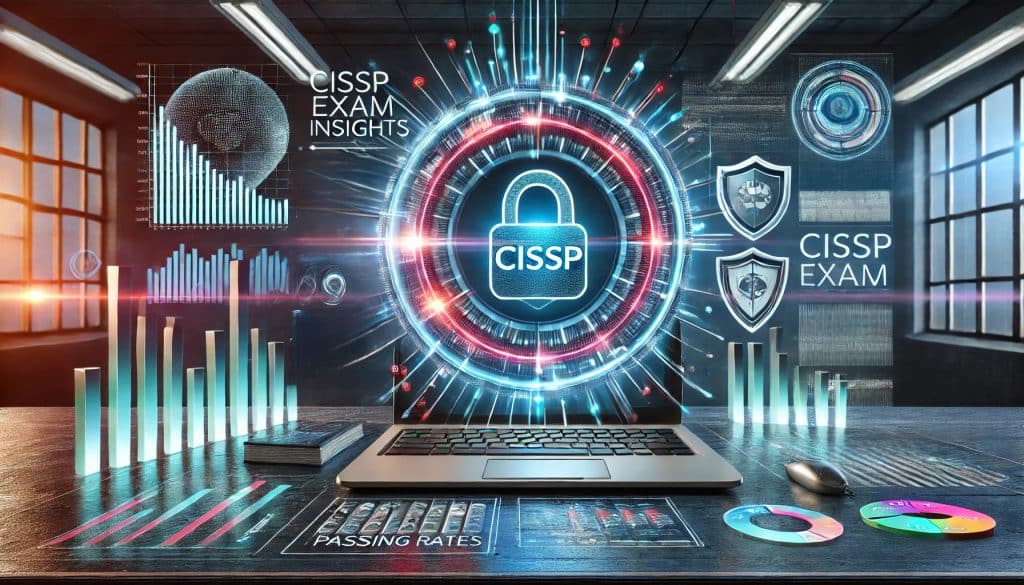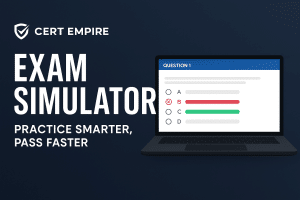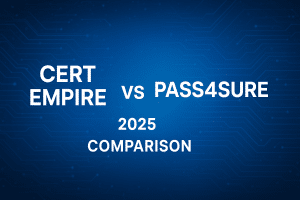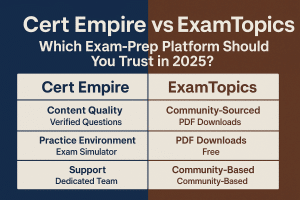CISSP Passing Score Uncovered: What You Really Need to Know
The CISSP exam is a big one for cybersecurity professionals aiming for the Certified Information Systems Security Professional title. If you’re here, you’re probably wondering what it takes to pass it and why it’s notorious for its difficulty. The passing score and pass rate are major points of interest because they paint a picture of just how challenging this exam can be.
Does the CISSP Exam Have a Passing Score?
CISSP Passing Score & Exam Format (2025)
| Passing Score | 700 out of 1000 (scaled score) |
|---|---|
| CAT Version | 100–150 adaptive questions, 3 hours max. Questions adjust in difficulty based on your answers. |
| Linear Version | 250 fixed questions, 6 hours duration. Used in select countries where CAT is not available. |
| Pass Rate | ~50% for first-time test takers (global average). Retakes are common due to exam difficulty. |
| Scoring Method | Competency-based. CAT evaluates consistency across all 8 domains, not just total % correct. |
| Updates | Exam content is updated every 3 years by ISC2 to reflect current threats, tools, and practices. |
| Tip The CAT format means you can’t skip or go back. Manage your time carefully and focus on showing consistent competence in every domain. |
|
Yes, the CISSP has a clear passing score, but the way it’s calculated isn’t exactly simple. For the computerized adaptive testing (CAT) version of the CISSP exam, you need to score at least 700 out of 1000 points to pass. But it’s not as easy as hitting 70% on every question. The adaptive test measures your ability to demonstrate competency across all domains rather than just scoring points in bulk. So, you could answer 100 questions, but if your answers suggest inconsistencies in key areas, you may not pass, even if you’ve got a lot of questions right.

For the linear, non-adaptive version, which some candidates take in specific countries, you also need 700 out of 1000 points. But that version has a set number of questions, usually 250, and the scoring is straightforward.
If you’re just starting your CISSP journey, make sure to explore this complete CISSP exam guide for an overview of the certification process.
Understanding the Adaptive Nature of the CISSP Exam
The CISSP CAT format is designed to zero in on your knowledge as efficiently as possible. You start with a medium-difficulty question, and the test adjusts as you go. If you get a question right, the next one might be harder. Answer it wrong, and you may get an easier one. This means that the difficulty can fluctuate throughout the exam. By the end, the system’s algorithm evaluates your performance based on how well you demonstrated understanding across all tested domains. For test-takers, this can make the CISSP feel unpredictable, which is part of what makes it so tough.

How CISSP Pass Rates Reflect Its Difficulty Level
What is the Average CISSP Pass Rate?
When we talk about CISSP pass rates, it’s obvious that the numbers don’t favor a casual approach. Reports suggest that the pass rate for first-time test takers is around 50%, which means half of the people who take it end up retaking it. This low pass rate tells us two things: first, the exam isn’t easy, and second, preparing for it requires focused study and strategy. Some regions may see slightly higher or lower rates, but the overall pass rate consistently hovers around this mark.
Why the CISSP Pass Rate is So Low (and What It Means for You)
The low pass rate isn’t just about the tough questions; it’s about what’s tested. The CISSP covers a vast range of topics, from network security to software development security. Mastering each area to the level needed for the exam is hard work. For someone without extensive, real-world cybersecurity experience, it’s even harder because you have to think like a security professional and use practical knowledge, not just theory. This means the exam is a mix of concepts, critical thinking, and applied problem-solving that’s designed to challenge even seasoned professionals.
Realistic Expectations: CISSP Exam Success Stories vs. Challenges
Some people ace the CISSP on their first try. Others struggle. What separates those groups? In many cases, it’s about experience and study approach. Those who succeed often do so because they’ve got years in the field and approach the exam in a way that connects their practical knowledge with what the test demands. They know not just what the right answer is but why it’s right. For those with less experience, the CISSP may feel more like a memorization challenge, but the test is geared to probe your real-world understanding.
Beyond just passing, one of the biggest motivators for candidates is the earning potential. Here’s a detailed breakdown of CISSP salary expectations in 2025 and beyond.
Navigating CISSP Exam Trends: What Changes Mean for Future Test-Takers
Recent Changes in the CISSP Exam and Their Impact on Scores
The CISSP exam evolves as cybersecurity trends change. For instance, in recent years, the exam has incorporated a greater focus on emerging threats and cloud security, reflecting real-world shifts in the industry. If you took the exam five years ago, it would look different than today’s version. ISC2 updates the exam content about every three years, which means that new topics and a slightly tweaked scoring approach can be expected each time they revise it.
The Growing Emphasis on Practical Security Knowledge
Recent feedback from test-takers suggests that the CISSP is moving away from questions that only test theoretical knowledge. Increasingly, questions ask you to apply security concepts to hypothetical scenarios that closely resemble real-world problems. This is great if you’re used to handling complex security situations, but it can be a hurdle if you’re more accustomed to academic-style exams. With this shift, having a strong grasp of practical security scenarios has become even more crucial.
How Often Does ISC2 Update the CISSP Exam?
ISC2 is known for keeping the CISSP exam relevant to current cybersecurity needs, updating it approximately every three years. Each update adds content relevant to the latest threats, tools, and security practices. For candidates, this means that your study materials need to be up-to-date. An outdated prep book may leave out crucial information on newer areas like cloud security or data privacy laws, which could impact your score.
Setting Your Strategy: How to Prepare for the CISSP Passing Score Threshold

Study Smart, Not Hard: Targeted Focus Areas for CISSP Success
There’s no single way to prepare for the CISSP, but focusing on the most heavily weighted domains can boost your score. Some high-yield areas are Security and Risk Management, Security Operations, and Asset Security. ISC2 emphasizes these areas for a reason – they cover foundational aspects that every security professional should know. Focusing on these while reviewing the remaining domains with a “big picture” approach can save you time and improve your chances of hitting the passing score.
What a Passing Score Feels Like in Practice
During the exam, you might feel uncertain about how you’re doing because of the adaptive nature. But there are signs to watch for. If you’re encountering a good mix of challenging and straightforward questions and feel comfortable with the core topics, it’s a positive sign. Some people describe the CAT format as an “uphill battle” where you’re constantly challenged, which means you’re probably on the right track.
Time Management in a CAT Exam: Maximizing Your Score Potential
The CAT format doesn’t give you the option to skip or go back to questions, so you’ve got to keep a steady pace. One thing that helps is to approach each question with confidence and avoid second-guessing. Since the test adjusts as you go, each answer you give influences what comes next. Rushing might lead to mistakes, while hesitating can cost you precious time. Aim for a rhythm that lets you think but not overthink.
Common Misconceptions About the CISSP Passing Score and Pass Rate
Debunking Myths About the CISSP Score Requirements
One common myth is that you need to score consistently high across all domains. In reality, the CAT exam is less about averaging scores and more about proving competence in each domain. You could do exceptionally well in some areas and just “meet the bar” in others, and still pass. Another misconception is that every question weighs the same – the CAT format means that harder questions might carry more weight in determining if you pass or not.
Does a High Score Mean High Expertise?
Passing the CISSP with a high score might feel great, but it doesn’t necessarily mean you’re a top cybersecurity expert. The exam focuses on testing a broad set of foundational knowledge, so while a high score shows you have strong understanding of concepts, it’s experience in the field that refines true expertise. Many candidates say that while the CISSP gave them a solid base, applying what they learned in real-life scenarios is where their expertise really grew.
The exam is notorious for being tough, but how tough is it really? This in-depth guide explains how hard the CISSP exam is and what makes it so challenging.
What CISSP Candidates Wish They’d Known About the Pass Rate and Exam Format
Key Insights from Recent Test Takers
Some recent CISSP candidates share that they wish they had known how crucial practice exams were. The CISSP isn’t a test you can prepare for by rote memorization; it requires critical thinking and problem-solving. Using practice exams to understand the logic of questions can make a huge difference. To get started, try free CISSP exam questions and experience what real exam-style questions feel like. Candidates also suggest pacing yourself during study sessions and not cramming all at once, as that can lead to burnout.
Avoiding Common Pitfalls and Overcoming Test Anxiety
A lot of people struggle with test anxiety, and the CISSP exam’s length only makes it worse. Experienced test-takers recommend grounding techniques, like deep breathing or quick mental breaks, to stay focused. Another useful tip is to avoid “information overload.” It’s better to focus on mastering the core topics than trying to memorize every detail across all domains.
Final Thoughts on Preparing for the CISSP Passing Score and Pass Rate Goals

Building Confidence by Understanding the Numbers
Knowing the passing score is only part of the journey – it’s about building confidence in your knowledge. As you work through study materials, gauge your own understanding and let that guide your prep. Passing the CISSP is achievable if you’re honest about your strengths and focus on areas that need improvement. Remember, this exam is about proving competence, not perfection.
Are You Ready to Take the CISSP? Self-Assessment and Next Steps
The best way to assess if you’re ready is to ask yourself if you could apply the principles of each domain to real-world scenarios. Are you comfortable explaining security frameworks, recognizing network vulnerabilities, or responding to a security breach? If the answer is “mostly yes,” you’re likely on the right path. Before scheduling your exam, take a final look at your weak areas and plan a few focused study sessions. Then, when you’re ready, trust your preparation and tackle the CISSP with confidence.
Most candidates dedicate months to preparation, but timelines vary widely. Here’s a practical breakdown of how long it takes to study for CISSP based on expert insights.
Last Updated on by Team CE



























